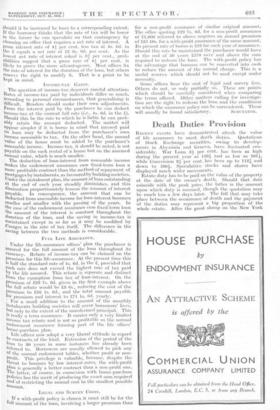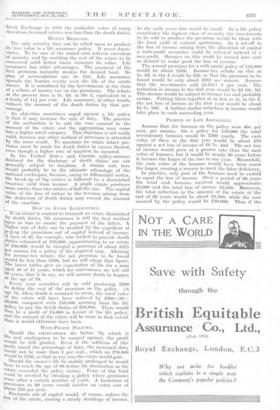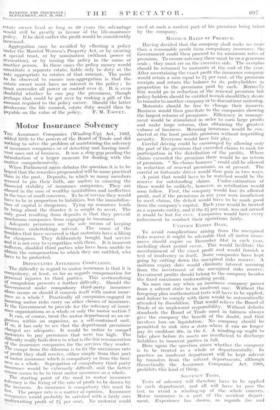Death Duties Provision RECENT events have demonstrated afresh the value
of life assurance to meet death duties. Quotations of Stock Exchange securities, owing to develop- ments in Abyssinia and Geneva, have fluctuated con- siderably. War Loan 8i per cent. has been as high during the present year as 1101 and as low as 101 while Conversion 8i per cent. has been up to 1121 and down to 104. Speculative stocks and shares have displayed much wider movements. Estate duty has to be paid on the value of the property at the date of the owner's death. Should that date coincide with the peak price, the latter is the amount upon which duty is assessed, though the quotation may be much less a few days later. The fall that may take place between the occurrence of death and the payment of the duties may represent a big proportion of the whole estate. After the great slump on the New York ' Stock Exchange in 1929 the realisable value Of' many American deceased estates was less than the death duties.
DUTIES REDUCED.
The only security that can be relied upon to 'producle its face value is a life assurance policy. It never depre- j eiates. To be sure of the stated sum relieves executotis !of anxiety, and by enabling the rest of the estate to be !conserved until better times increases its Value. Life assurance has other advantages. The payment of the first premium instantly creates the desired fund. No plan of accumulation can do this. Life assurance ' spreads the burden evenly over the life of the estate • owner. It is subsidised by. the Government in the form of a rebate of income tax on the premiums. The rebate at the present time is 2s. 8d. in the £, equivalent to a s tbsidy of 111 per cent. Life assurance, in other wordS, reduces the amount of the death duties by that per- ' tentage. ' An objection sometimes urged: against a life policy is that it may increase the rate of duty. The practice of the authoritieS is to add the 'sum assured to the amount of the estate and the aggregation may come into a higher rated category. This objection is not really Valid,. because any other method of provision is attended . by the same result. To maintain an estate intact pro- vision must be made for death duties in excess thereof, even though a higher rate of taxation. be incurred. ' In the United States. and Canada policy-moneys destined for the discharge of death duties are not generally subject to taxation. A similar rule here would probably be to the ultimate advantage of the national exchequer, because; owing to differential surtax, the break-up of big. estates is followed by a diminished taxation yield from income. A single estate produces more surtax than two estates of half the size. The capital value of the loss of surtax to the revenue arising from the deduction of death duties may exceed the amount of the exaction.'
How TO AVOID AGGREGATION.
If "iiif-oWrie-fia. Content-t6 transmit an estate ditninished ;oy death duties, life assurance is still the best method !open to him to ensure the payment of the latter. A :higher rate of duty can be avoided by the expedient of ylng the premiums out of capital instead of income. Lei. man of 40, for example, who wished to provide death dirties estimated at £10,000, approximating to an estate of £60,000, would be charged a premium of about £225 Per annum for a policy of, the net sum. Allowing !for income-tax rebate, the net premium to be found ;would be less than 1200,.. but we will adopt that figure. .The latest tables give an expectation of life for a man aged 40 of 31 years, which for convenience we will call '30 years, "that is to say, we will assume death to happen at the age of 70. Every year securities will be sold producing £200 to defray the cost of the premium- on the policy. At ;age 70, when death is assumed to occur, the total value of the estate will have been reduced by i1/4200 X 30= '13,000, compared with £10,000 accruing from the life Policy to pay. the death duties of £10,000. There would thus be a profit of £4,000 in favour of the life policy, and the amount of the estate will be more to that extent than it Would otherwise havC been.
WITH-PROFIT POLICIES.
Should the estate-owner -"die before 70, which fs the real contingency to be assured against, the profit would be still greater. Even if . the addition of this Profit raised the percentage of duty, the increased duty would not be more than 1 per cent., which on £70,000 Would be £700, so that in any case the estate would.gain. , Should the owner's life be unduly prolonged he would have to reach the age of 90 before the diminution in the estate exceeded the policy money. Fears of this kind could be averted by choosing a policy where premiums "tease after a certain number of years. A limitation of Premiums to 80 years would involve an extra cost of about £20 per year. Payments out of capital would, of course, reduce the 1size of the estate, causing a steady shrinkage of income. In the early years this would be small. As a life policy !constitutes the highest class of security the investments to be sold to produce the premium would be those with the least yield at current quotations. As a set-off to the loss of income arising from the allocation- of capital a with-profit assurance could be selected instead of a non-profit. Bonuses on this could be turned into cash as desired to make good the loss of income. The annual premipm for a with-profit policy of £10,000 would,-, be about £.820.Income-tax .rebate On this at 2s. 8d. in the £ would be £86, so that the premium to be found would be only about £284 per annum. Assume that • the investments sold, yicldei 3 per . cent... The reduction in income in thefirst year Would be £8 10s. 5d. This income would be subject to income tax and probably surtax. Putting these together .at as low as 5s. in the £, the net loss of income in the first year would be abotit 16 7s. lad. A further similar reduction in income would take place in each succeeding year.
PROFITS OF LIFE ASSURANCE.
Assume that the bonuses on the policy were 40s. pgr cent. per annum. On a policy for £10,000 the total reversionary bonuses would be £200 yearly. The cash value of these in the first year would be about £70. against a net loss' of income of £6 7s. 10d. The net loss of income would grow at a greater rate, than the cash Value of bonuses, but it would be nearly.20 years before it became the larger of the two in one year. . Meanwhil, the cash value of the bonuses would have been much the larger, creating a reserve to meet the later deficiency. In practice, only part of the bonuses need be cashed to equal the loss of income.' Over a period of 80 years the total cash bonuses received would approximate £3,000 and the total loss of income £2,950. Moreover, the total reduction in the amount of the estate at the end of 30 years 'would be about £8,500, while the sum assured by the policy would be £10,000. Thus if the estate owner lived as long as 30- Tears. the .advantage would still be greatly in faVour of the life-assurance policy. If he died earlier the profit would be considerably increased. . Aggregation may. be • avoided by effecting a policy W under the Married Women's Property (without or by creating a special - trust, or by nomination (without power of revocation), or by, issuing the policy in the name. of another person. In these cases the policy money would Constitute a separate estate, liable, only to duty at the .rate. appropriate to estates of that amount. The point • to be observed to ensure non-aggregation is, that the estate owner must :have no interest..in the policy ; he must surrender allpower or control over - It is eve!' doubtful whether he can pay.. the premiums, though perhaps that could be got over by making .a gift of the amount required to the policy owner. . Should, he latter predecease the life assured, estate .duty would then be -Payable on the value of the pOlicy. F: M. ToovEY. .




























































 Previous page
Previous page